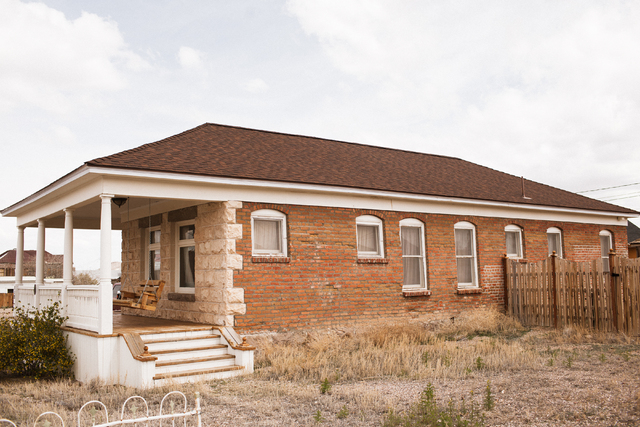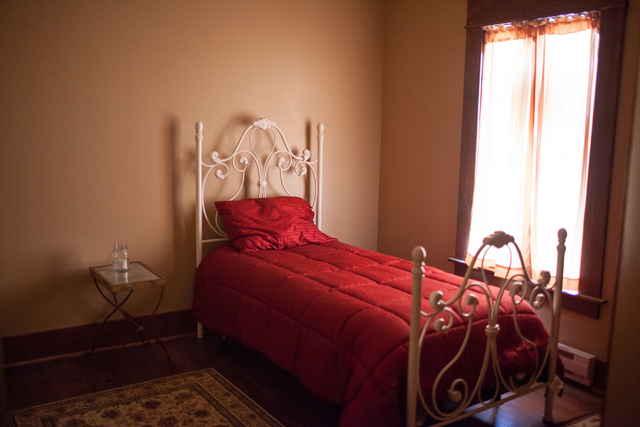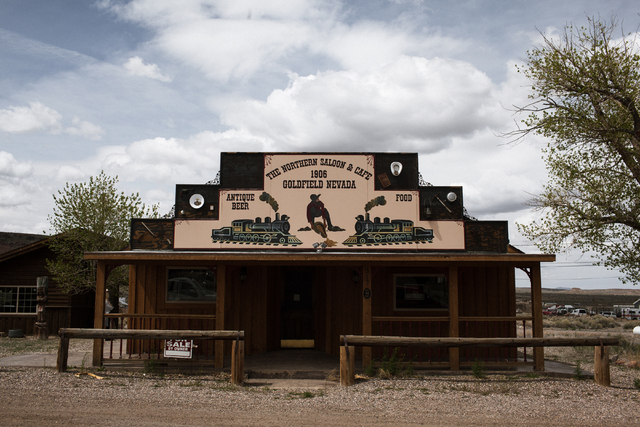Dust-up surfaces over disputed Virgil Earp connection to Goldfield house
GOLDFIELD — As a girl, Ruth Andersen remembers those drives north along U.S. Highway 95 from her home in nearby Beatty, when her father and uncle drove her to youth basketball games in Tonopah and the cramped gymnasiums beyond.
Later, the men stopped for beers in Goldfield, and Andersen recalls seeing all those vacant lots and run-down shacks in the former gold-mining boomtown that was once Nevada’s largest city.
Decades later, as a successful Utah-based demolition expert, Andersen decided to invest in Goldfield as a way to preserve this memory-rich vein of Nevada history.
She spent several millions buying up numerous properties that were crumbling back into the desert. One was the house on Fifth Street, which old-timers told her was once briefly inhabited by famous Western lawman Virgil Earp, brother of Wyatt, who took part in the historic shootout at the OK Corral in Tombstone, Arizona.
Andersen spent $250,000 refurbishing the wood-and-brick property, later willing it to her niece. Now the house is up for sale, advertised on leaflets around town that beckon: “Own a Piece of History: Virgil Earp’s home.”
The only problem, says the Goldfield Historical Society, is that it’s all wrong.
“We know that Virgil Earp lived here, but we don’t know where,” said historical society president John Ekman. “We do know this, however: He didn’t live in that house. And we have the records to prove it.”
When it comes to authenticating history, such dust-ups are not uncommon. In the rough-and-tumble settlement of the American West, documents were often shoddy, poorly recorded or never established. At other times, people often accepted human recollection as fact, clouding the public record.
“It happens,” said historian Dennis McBride, now head of the Nevada State Museum in Las Vegas. “People who aren’t privy to the public record sometimes rely on unofficial word-of-mouth stories passed down generation to generation. Too many times, unfortunately, such stories are taken as fact.”
Most bona fide property histories, he said, are found in assessor, tax and building records and in newspaper archives. “That’s where you find the truth of a given story,” he said.
Growing up in Boulder City, McBride often heard the story that both Herbert Hoover and Franklin D. Roosevelt had once stayed in the historic Boulder Dam Hotel. Hoover supposedly visited the dam during its construction, and Roosevelt showed up to dedicate the structure.
“You heard the stories again and again; they’re even online,” McBride said. “But the fact is that the hotel didn’t open until 1933, too late for either of those events to happen. Neither man ever stayed there. But it makes for a great story. Until you start digging and find out that it’s not true.”
In Goldfield, the disagreement has caused some ruffled feathers and bruised egos.
Vanessa Lucido, Andersen’s niece and a Realtor who has put the property up for sale for $150,000, wrote off the local real-estate rhubarb to petty small-town jealousies.
“In small towns, nobody wants their neighbor to have any claim to fame,” she said. “Those people all stood by when my aunt spent millions renovating these historic properties.”
To be sure, there is plenty of history in Goldfield.
Founded as a tent city by 20 hardy miners in 1902, Goldfield soon boasted 20,000 residents, a teeming gold mining haven with 49 saloons, 27 restaurants, 22 hotels, 21 grocers, 17 laundries, 15 barber shops, 14 cigar stores and six bakeries. The place also provided work for 84 attorneys, 40 doctors and 10 undertakers, according to published reports.
The town would produce some $83 million in gold between 1903 and 1940. Much of the original town, however, was destroyed in a 1923 fire.
On Jan. 26, 1905, records show, Virgil Earp was sworn in as an Esmeralda County deputy sheriff who moonlighted as a bouncer at the National Club, a bustling town casino. A story in the Tonopah Sun reported the casino’s hiring of “one of the famous family of gunologists.”
Still powerful at age 62, Earp had nonetheless sustained some damage in an Arizona mine cave-in as well as crippling wounds in Tombstone that left him with one functioning arm.
In the fall of 1905, Earp fell prey to a pneumonia epidemic that swept through Goldfield. Stories differ, however, on just where he died. One version has it that the old lawman succumbed at St. Mary’s Hospital in Goldfield. A daughter, Nellie Jean, from Earp’s first marriage, asked that his remains be sent to Oregon, where he was finally buried, in Portland’s Riverview Cemetery.
In her memoirs, Earp’s last wife, Allie, wrote that he said to her, “Light my cigar, and stay here and hold my hand.” Those were reportedly his last words.
Andersen said that some old-timers in Goldfield told her that Earp might have even died at the house. That’s just one claim the local historical society disputes.
“Virgil Earp was dead before the house was even built,” Ekman said. “The first railroad did not arrive in Goldfield until the fall of 1905. Before that, the brick that was used to build that house would have been too expensive to bring here.”
Ekman said the historical society hired an Arizona firm in 1981 to perform records searches on all the properties in what would become the town’s historic district.
“We are trying to develop the true history of Goldfield, which is extremely rich and colorful without having to suggest what is not the case,” he said.
According to the Goldfield Historic Property Survey, the house Andersen bought was built by masonry contractor Charles Kline in the fall of 1908. The structure was later sold to resident Frank L. Beard, who lived there until his death in 1945.
“But Ruth has her own ideas about things,” Ekman said. “She’s repeated things she’s heard.”
Andersen acknowledged that she has not researched property records. Because Earp only rented there, she’s not surprised that his name did not come up in official searches.
She says she has her own eyewitness history.
Andersen said the house was in such disrepair when she bought it in 2003 for $125,000, she began a major renovation. “We tore that house down to its studs,” she said. “And we found one piece of wood marked Kline 1905.”
In the drawer of an old cabinet, she also found law enforcement badges, bearing the inscriptions “Sheriff Tombstone Az. Territory,” “Railway Express Special Agent” and “Marshall Dodge City.”
Andersen said she does not know if the badges are authentic.
Earp or no Earp, the house is worth far more than the asking price, considering the money she put into it, Andersen said. Either way, the 65-year-old explosives expert called her work renovating the property a grand adventure.
“I loved doing it,” she said. “When you take apart an old historic building, it tells you a story. And when you put it back together, you want the story to go with it.”



























